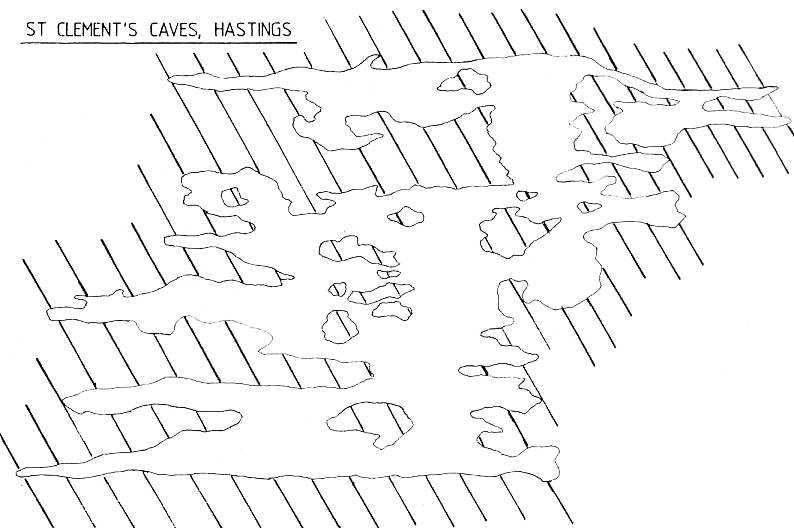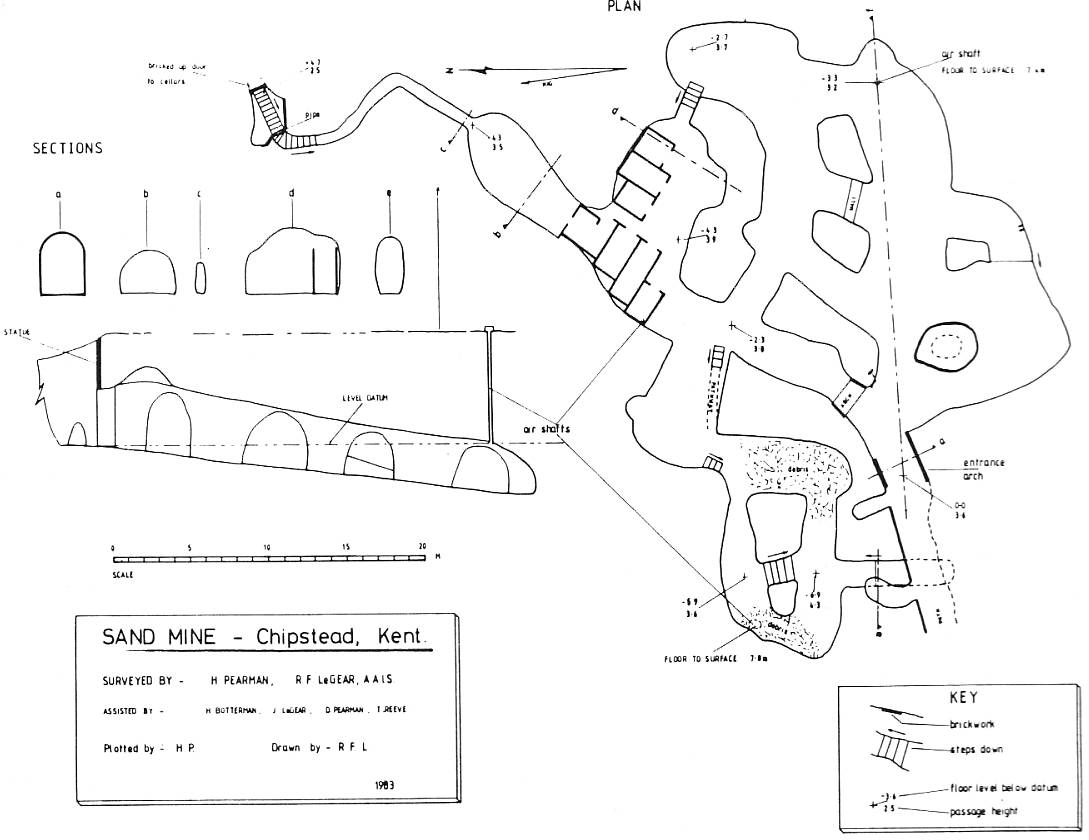Sand & Sandstone Mines
Sand is basically small crystals of silica which, in their pure form, are colourless or white. They are often discoloured by impurities and, whereas the usual colour of sand is yellowish orange, it can be found in just about every colour imaginable. It has had many uses over the years and is especially important nowadays in the building industry as an ingredient of mortar and cement. Before this, however, one common use was in drying ink on documents before blotting paper and the biro were invented. Another use, still important today, was as the raw material for glass making but only the purer forms could be used for this.
The usual reaction of people to a sand mine is that someone is pulling their leg! After all, why mine it when it could be quarried at surface and how could a mine in sand exist without collapsing? The simple answer to the first question is one of economics — where sand deposits were close to the surface then quarrying was easy but where they were deeper it was quicker to mine than remove large amounts of overlying strata. The weight of the latter causes the sand deposits themselves to be compressed at depth and this sand is nothing like the loose sand found on beaches. With careful excavation, the material is surprisingly stable and does not need support.
From a mining point of view, sand is perhaps one of the easiest materials to work in since it can be extracted with pick and shovel. Horizontal passages were driven into the hillside, sometimes from an existing sand pit, and side passages were developed to form a maze of workings. In view of the soft nature of the sand, some skill was called for in shaping the passages so that the cross-section formed an arch with a rounded roof. This spread the weight of overlying strata and meant that extra support was rarely needed. Dimensions varied but passages were normally 6-8ft high. The weak points were at the passage junctions where a greater area of roof was unsupported. Unless these were excavated with great skill, there was a danger of roof collapse and many sand mines have collapsed at such points. Surface remains are almost non-existent since the sand was saleable in its mined form and there was no need for surface treatment.
Perhaps the most well known sand mines are the St Clement's Caves at Hastings, which are some 3 acres in extent. There are reports of sand being mined at several sites in the Hastings/St Leonard's area, one as late as 1858, and some of these are still accessible. Although the St Clement's Caves can not be accurately dated, a smaller sand mine nearby was excavated before 1783 since a report at that time described how a man and his wife were living in it ’ . . . having been discharged from the town workhouse for repeated misbehaviour'! They showed some enterprise by guiding visitors around their 'gloomy abode' for a few pence. This seems to indicate that sand mining had taken place here at least in the 18th century since it had ceased by 1783. In 1797 the St Clement's Caves were enlarged to make a temporary hospital for the Worcestershire Militia and in 1827 were developed as a show cave. In World War II the town archives were stored here but it was stated that they were so ravaged by the atmosphere that they would have been better left to the mercies of the enemy! What the sand mined here was used for is unknown but it was possibly for building purposes.
There is a sand mine at Greenwich which is accessible from the garden of a private house. It is believed that sand from here was used locally to make cheap green bottle glass and/ although the date of working is unknown, glass making was carried out locally from the 17th century. In 1905, the Greenwich Borough Council stated '. . . We have also visited and examined a complicated and lofty series of tunnels . . . cut into hard sand and extending over a considerable area'. Another report in 1914 described a sand mine in this area ' . . . I do not know the exact extent of these excavations but one can wander about in what seems to be a perfect maze of tunnels for a considerable distance'. The presently accessible mine is nothing as great as the reports suggest so, unless there was some exaggeration, there must either be further workings beyond the roof collapses or another mine as yet unfound.
A sand mine at Chipstead seems to have been associated with a whitening works in the quarry from which it was driven. It is possible that the fine, white sand was compressed into blocks for cleaning doorsteps. The earliest graffiti in the mine suggest a date of working prior to 1864 and it was worked up until the early 20th century. Subsequent to this it was used as a film store and as an air raid shelter in World War II.
To the north of Maidstone, between Aylesford and Hollingbourne, is found a deposit of particularly fine white sand which was used locally for glass making. It once had such a good reputation that it was sent to London and other parts of England, being used in the manufacture of Ravenscroft's flint glass tableware in the 17th century. Its particular value lay in the lack of impurities and a report in 1834 stated ‘ . . . small white crystals are frequently found in the sand in this parish, they are exceedingly hard and, when polished, are very brilliant; they are known in this neighbourhood by the name of "Bearsted Diamonds".' At Aylesford, it was sufficiently shallow to quarry and the sand pit here produced it for glass making until 1916, since when it has had a more ignominious use in building. Further east, however, it was too deep and it was mined by means of horizontal levels driven into the hillside.
The first site is in Penenden Heath where there was an old sand pit. It seems very likely that underground levels were driven west from this pit since a serious subsidence occurred at Norman Close in 1976. A 15ft crater appeared with 'an enormous cavern' below. Another mine is near Newnham Court and the collapsed entrance is at the bottom of a large open pit 300ft long, 240ft wide and 90ft deep. The original date of working was at least the 18th century and perhaps even before. By the mid-19th century it had ceased working but, before then, it had become one of the local attractions for visitors to the area. A report by W. Lamprey in 1834 describes a visit to the mine and, allowing for artistic licence, is a useful insight into the workings. ' . . . On our way home from Thurnham we visited the remarkable sand caverns at Newnham Court Farm; and really they are well worthy of notice. These subterranean passages are so long and intricate as to render the assistance of a guide necessary. The boy, who conducted us, said that the length of the various pits exceeded half a mile and that formerly their length was much greater, more than a half part of them having been filled up by the falling in of earth above, in consequence of the excavators having imprudently cut away the points of support where some of the passages intersected each other. Those persons who intend to descend far into these caverns should provide themselves with a firebox as many have, by their torches being extinguished, been lost in their gloomy and dangerous maze for hours. From these pits, many of the provincial glass manufacturers and stationers in the kingdom are supplied with the fine white sand used in their trades'. The references to the collapses describe a practice known in mining circles as 'pillar robbing'. When a mine was at the end of its economical life, it often happened that miners obtained fresh material by enlarging passages or whittling away solid pillars left as support. This was a dangerous practice but it meant that material could be excavated quickly and cheaply.
On Hockers Lane is a disused sand pit from where levels were driven west under Popes Wood. A number of depressions show the collapse of the sand workings underneath this point and a cavity appeared in Hockers Lane itself during drain laying. At Hog Hill in Bearsted there are a number of craters that are very likely to be collapsed sand workings. A nearby subsidence at the railway station, when several tons of coal disappeared, is probably due to a similar cause. Other craters at Commonwood are collapsed levels driven from a nearby sand pit.
At Hollingbourne there was the entrance to another large sand mine that has now, unfortunately, been almost completely destroyed by the construction of the M20. This mine seems to have been worked to a later date than the one at Newnham Court and it is believed that sand from here was used to make glass for Crystal Palace around 1850. It seems to have closed soon after this but was 're-discovered' in 1898 by a local boy out exploring. The landowner and tenant, Messrs Fremlin and Coveney, opened it to the public as a show cave for 6d a visit and it operated right up to the 1960s. Tool marks were still visible in the walls and the sand contained boulders of iron ore, known locally as 'car stones'. At one point, there was a round shaft in the ceiling leading to a chamber with access to the surface. This is unusual for a sand mine of this type and may have been earlier workings broken into by later mining. The quarry site, from where the entrance went in, is now occupied by a haulage firm.
In some areas, sandstone rock was mined where the surface deposits were too shattered to make large enough blocks for building stone. At Tunbridge Wells a small shaft was found leading to a large excavated chamber in sandstone. It is possible that this originally supplied building stone and it was made use of in the last war as an air raid shelter. At Cowden there are four short adits in a sandstone cliff and nearby is a 50ft adit some 9ft high x 5ft wide. Little is known of their origin but one theory is that the sandstone could have been mined as a furnace lining.
In East Sussex, sandstone was mined in the area of Brightling/Netherfield but the locations are still something of a mystery. The reports of the HM Inspector of Mines between 1895 and the early 1900s list 3 working mines for 'calcareous' sandstone but did not pinpoint where they were. The Blackbrooks Mine and Perch Hill Mine were both owned by Percy Tew of Brightling (later taken over by the mine agent W. Haviland) and it is likely that they were eventually linked underground. The number of miners averaged 10 and the only clue to the location is that they were 7.5 miles from Battle Station! The entrances have not yet been found but they are likely to be between Perch Hill and Willingford. The other site was Woodlands Mine which was originally owned by S. Crowhurst of Netherfield. It seems that he was better at mining than finances since he sold out to C. Egerton of Mountfield in 1899 but stayed on as mine agent. This was a smaller mine with an average of only 4 miners and was said to be 4 miles from Battle Station. Again, the entrance has not yet been found but it could be near Woodlands Farm.

